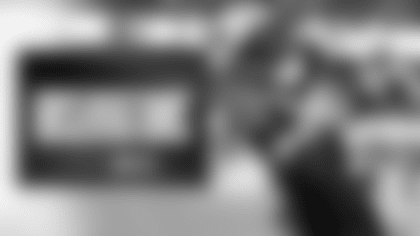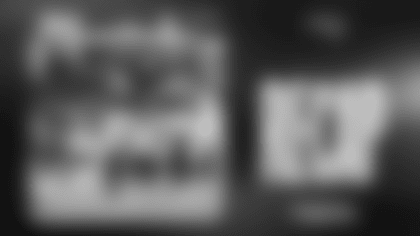It creates wrap-around images like those of Keanu Reeves in The Matrix trilogy, has won CBS Sports an Emmy in May and has been called "eye candy" by a career TV broadcasting technologist. And it could be coming to a screen near you.
It's widely known as EyeVision 360. It's tried and true technology, not a promising possibility growing old on the launch pad.
In fact, fans at the Ravens vs. the Panthers pre-season home game on August 11 were served up ground-breaking 360-degree replays on big boards, a practice that's taking root at Levi's Field and AT&T Stadium as well.
Sweeping Sports

The tech-fueled 360 degree replays on some of the league's largest video boards use a networked ring of elevated cameras – dozens operating as one - to give fans a complete picture of past plays.
That's opposed to six networked cameras used today to produce far less engaging replays for big video boards.
The centrally-controlled, server room-based system is called Eyevision 360 and became a key element in CBS's coverage of Super Bowl 50 February at shiny new Levi's Stadium.
https://vimeo.com/157809580
The league was so taken that it let officials used the 360 replays to help review plays during its most celebrated and high-stakes game.
EyeVision 360 was developed by pioneers CBS Television with robotics experts at Carnegie Mellon. The freeD tech of Replay Technologies is at the core. Replay describes freeD as "a revolutionary three-dimensional visual data format which changes the way we interact with video." The tech innovator has also provided the skilled staff needed – where needed - to run it during a game.
Earlier this year, the NBA called on Replay Technologies, which Intel Corp. has purchased, to provide 360 views of plays to fans in the stands, watching on TV and tuning in online for the league's All-Star weekend. The tech is now officially referred to as Intel freeD technology.
"This system allowed broadcasters to give fans a 360-degree view of key plays – providing thrilling replays and highlight reels that let fans see the slam dunks, blocks and steals from almost every conceivable angle," explained Wendell Brooks, senior vice president of Intel Corporation and president of Intel Capital in a blog.
A 28-camera array was used at this year's NBA All-Star game as were high-performance Intel-based servers.
Seeing is Believing
For all those that haven't yet seen a 360 degree replay, visit Replay Technologies for an example http://replay-technologies.com/ . You'll agree that this approach provides far more angles, and together as a complete entity, of game action. "It's eye-candy for fans in the stands," proclaimed Ken Aagaard, the recently promoted to EVP of Innovation and New Technologies for CBS.
And in what seems a short period, Replay's tech has won supporters such as tech-savvy Dallas Mavericks Owner Mark Cuban and the Los Angeles Dodgers. Its clients include the NCAA, UEFA and the USTA (in addition to the PGA, MLB, NBA and NFL.

The same holds true for those pro football teams who have seen what the tech-powered system can do.
"Fantastic... the fans can't get enough of the captivating freeD images we show in stadium," said Cowboys Chief Brand Officer and Executive VP Charlotte Jones in a testimonial for Replay Technologies." We can't wait to see what is next from the team."
The Cowboy's AT&T Stadium, with its gigantic video board, was a natural for the 360 replays where perhaps more attendees have a better view of the screen than the action on the field. A sizable screen or screens is a must-have to display the replays to the largest possible audience.
This dovetails nicely with next-gen stadiums-in-progress in which huge video boards or loops are a core feature.

In Minnesota, the Vikings; stadium-in-progress will open with an 88 x 15-foot East board and a 120 x 68-foot south video board, with 2,000 smaller units to blanket the stadium. And in Atlanta, the work-in-progress Mercedes Benz venue will feature a contiguous, 360-degree screen called the Halo board just below a roof that closes in a circular approach.
Huge video boards are not essential but do help display the 360 replays to the largest audience. The real value here is the next-gen replays that are a huge step up from the standard "flat" fare.
How it Works
The replay system typically features over 30 networked very high-res cameras that are hung in a circle of sorts hung up over the field of play. When in use, video is captured and sent via high-speed lines to a bank of fast servers. The operator stitches together the video clips into a replay – sometimes with help from the team's production staff –again over wired links – to the targeted end zone screens and/or video walls.

The process takes around 20 seconds in total, though that time is currently under work to be shortened. This can limit the systems use in certain situations. Commercial breaks and challenges are best friends with EyeVision, "but hurry up situations pretty much kills the opportunity to deliver a 360 replay," explained CBS' Aagaard.
Then and Now
Aagaard was there from the beginning and has seen the 360 replays go from a magnetic concept to an engaging reality – one that fuels the NFL's ongoing and longstanding goal of improving the fan experience. He was on hand in 2001 when 360 replays took the stage at Super Bowl 35 between the Ravens and Giants.
Some 15 years later, Aagaard, Replay Technologies and the league found themselves readying EyeVision for its roles in the NFL's Super Bowl 50 at Levi's Stadium in the November before the historic event with work to be done.

The SB 50 system used 5K cameras, the highest resolution units ever used before, to capture the game action. Aagard's crew got it done with one game before the SB left to test the enhanced systems. "We made it a reality on a wing and a prayer," he recalled.
The system was integrated with other CBS resources – pylon cams, zoom capability using 4K resolution – that together were used to capture video from SB 50.
Lights, Cameras, Action
"We never got that moment," said of a disputed make-or-break play or call that EyeVision could help resolve so that the headline on the SB news coverage would not contain the phrase controversial call. "We were devastated," Aagaard admitted. "We didn't get to put the system to (real) use."
Though EyeVision wasn't called to make the difference in the most watched annual TV event in the world, its 360 replays gave fans a clear look at things to come from other stadiums, TV and the Internet.
Since SB 50, they have been used to boost the fan experience in the NBA and in the PGA Open for example.
They caught the attention of decision makers at Intel Corp. which purchased the Israeli-based Replay Technologies this past spring.
What's Next?
Replay Technologies Parent Intel and business partners are well into a new release of the offering with features that should provide officials easier visual means to decide reviews and the league a more precise means than change gangs to determine measurements (such as first downs made/missed).
One shortcoming however is unlike using a sensor in the ball that could someday be tracked; the ball has to be seen for the plane approach to work.
And when the broadcast teams have access to the 360 replays they would be able to provide fans a more analytical, detailed take on what they see.
With 30-plus super high-resolution cameras covering the field the company has been hard at work on a "blue plane" which looks like a vertical pane that could be used to determine for example when a player crosses the goal line into the end zone. Today's is imperfect and many have problems with that. The same goes for whether a player crosses the plane the yellow line for TV.
The Bottom Line
When will you see 360 replays go mainstream? In the NFL, team acceptance of the "eye candy" depends in part on how it's offered. The same appears to hold true for broadcasters who could bring these next-gen replays to your home via TV and the Internet. It need to be offered in a way that allows its used beyond marquis events.
Given its traction in and outside the NFL (NBA and PGA to name a few) and a possible packaging with servers made by parent Intel that could be offered as a sort of managed service could serve to broaden the spread of 360 replay sooner rather than later.
Stay tuned.
Bob Wallace is a technology journalist with over 30 years of experience explaining how new services, apps, consumer electronic devices and video sources are reshaping the world of communications as we know it. Wallace has specific expertise in explaining how and why advances in technology redefine the way sports teams interact with their partners, players and fans. He's the Founder of Fast Forward Thinking LLC.
































